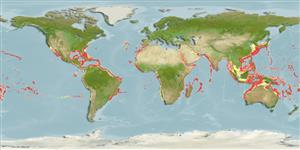>
Aulopiformes (Grinners) >
Notosudidae (Waryfishes)
Etymology: Scopelosaurus: Greek, skopelos = a lantern fish + Greek, sauros = lizard (Ref. 45335).
Eponymy: Dr Hugh McCormick Smith (1865–1941) was an American physician (1888) who became an ichthyologist. [...] (Ref. 128868), visit book page.
Environment: milieu / climate zone / depth range / distribution range
Ekologi
laut bentopelagis; oceanodromus (Ref. 6689); kisaran kedalaman 50 - 815 m (Ref. 13608). Tropical; 40°N - 30°S
Eastern Atlantic: off Madeira and at 20°N 30°W. Western Atlantic: 34°N to 20°S, with some larval drift up to 40°N. Elsewhere, Indian and Pacific Oceans between 20°N and 30°S.
Size / Weight / umur
Maturity: Lm ? range ? - ? cm
Max length : 25.0 cm TL jantan/; (Ref. 6602)
deskripsi pendek
Kunci identifiaksi (pengenalan) | Morfologi | Morfometrik
Duri punggung (Keseluruhan (total)) : 0; duri punggung lunak (Keseluruhan (total)) : 10 - 12; Duri dubur: 0; Sirip dubur lunak: 17 - 19; vertebrata, bertulang belakang: 53 - 56. Blackish on head and back; paler below (Ref. 6602). No distinct black spot surrounding anus (Ref. 13608).
Larvae are epipelagic, young inhabit the layers between 50-200 m, adults benthopelagic and found deeper than 500 m over continental and insular slopes (Ref. 6552, 6602). Mesopelagic (Ref. 58302). Feeds mainly on zooplankton. Extensive migrations by juveniles and adults, probably for feeding in the subtropical belts. Spawning occurs in tropical waters, especially in the western part of the Atlantic Ocean (Ref. 6689).
Life cycle and mating behavior
Kematangan | Reproduksi, perkembang biakan | Pemijahan | telur-telur | Fecundity | Larva
Krefft, G., 1990. Notosudidae. p. 361-364. In J.C. Quero, J.C. Hureau, C. Karrer, A. Post and L. Saldanha (eds.) Check-list of the fishes of the eastern tropical Atlantic (CLOFETA). JNICT, Lisbon; SEI, Paris; and UNESCO, Paris. Vol. 1. (Ref. 6552)
Status IUCN Red List (Ref. 130435: Version 2024-1)
ancaman kepada manusia
Harmless
penggunaan manusia
Perikanan: tidak ada kepentingan
Alat, peralatan
laporan khas
muat turun XML
Sumber internet
Estimates based on models
Preferred temperature (Ref.
123201): 9.6 - 20.6, mean 14.5 °C (based on 680 cells).
Phylogenetic diversity index (Ref.
82804): PD
50 = 0.5001 [Uniqueness, from 0.5 = low to 2.0 = high].
Bayesian length-weight: a=0.00295 (0.00121 - 0.00721), b=3.18 (2.96 - 3.40), in cm total length, based on LWR estimates for this (Sub)family-body shape (Ref.
93245).
Trophic level (Ref.
69278): 3.4 ±0.45 se; based on food items.
Fishing Vulnerability (Ref.
59153): Low vulnerability (15 of 100).
